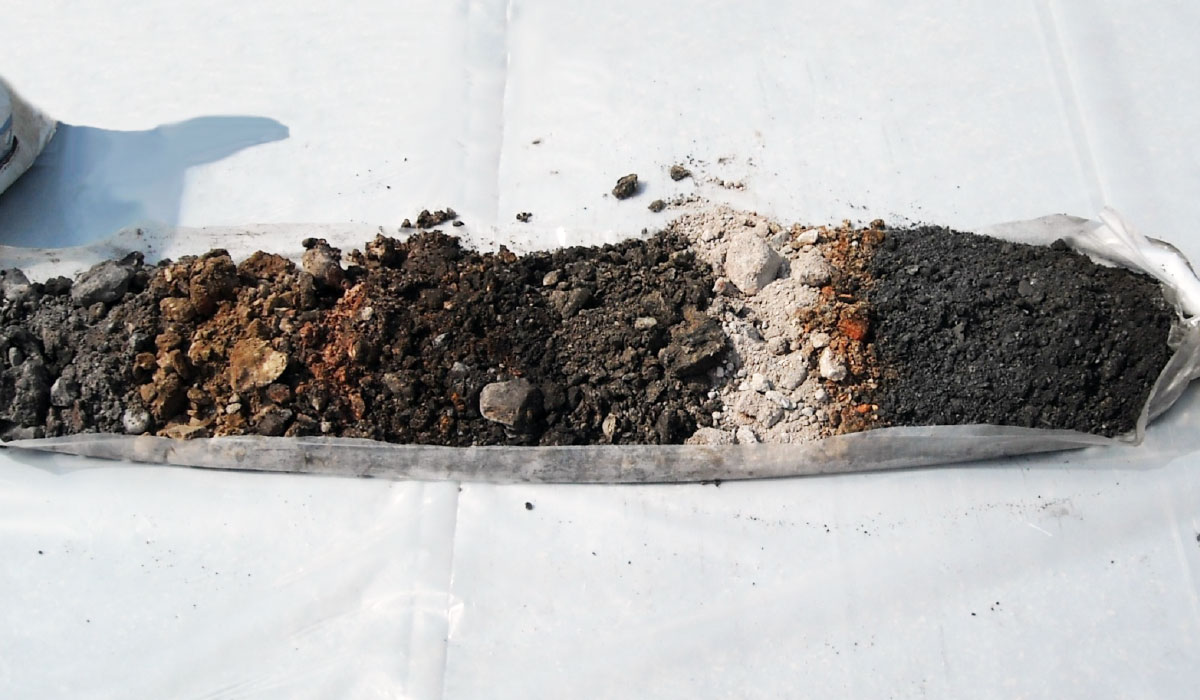BETRIEB MINE
8. Mai 2017
Sonic Drilling: Eine solide Lösung für frustrierende Formationen
Eine der häufigsten Herausforderungen im Bergbau besteht darin, eine qualitativ hochwertige Kernprobe aus unkonsolidiertem oder fragilem Boden zu gewinnen. Mit SchalltechnologieBergbauunternehmen stellen fest, dass sie diese Herausforderung meistern können, mit einer Genauigkeit und Effizienz, die mit herkömmlichen Bohrtechniken nicht erreicht werden kann.
Sonic Bohren nutzt hochfrequente resonante Energie, um ein Kernrohr in unterirdische Formationen zu bringen. Während des Bohrens wird die resonante Energie mit verschiedenen Schallfrequenzen vom Bohrstrang auf die Bohrerfläche übertragen. Die gleichzeitige Rotation der Saite verteilt die Energie und den Aufprall gleichmäßig auf die Meißeloberfläche und ermöglicht einen effizienten Vorschub der Saite. Sobald sich die Probe im Kernrohr befindet, wird ein Außenmantel in derselben Tiefe über das Fass gebohrt. Es ist keine Flüssigkeit oder Wasser erforderlich. Durch diese Technik bleibt das Loch in Formationen stabilisiert, die anfällig für Höhlenbildung sind, wie loser oder hebender Sand, Lehm, Schotter, Kies, Felsbrocken oder Pflastersteine
Das Folgende ist eine Zusammenfassung des Berichts Sonic Drilling für Bergbauanwendungen
Laden Sie den vollständigen Bericht herunter um Fotos von Kernproben zu sehen, die durch Ultraschallbohrungen hergestellt wurden, sowie Fallstudien erfolgreicher Anwendungen.
✕Sonic Bohren bietet deutliche Vorteile:
Übergeordnete Informationen: Da der Schallschnitt den Boden sauber abdeckt und keine Flüssigkeit zur Verdünnung der Probe vorhanden ist, führt dieses Verfahren zu einer relativ ungestörten Probe durch jede Art von Boden. Sie erreichen eine Kernwiederherstellung von nahezu 100 Prozent oder in der Nähe, und zwar kontinuierlich bis in die Tiefe. Dies bedeutet überlegene Untergrundinformationen für die Entscheidungsfindung.
Geschwindigkeit: Durch die Kombination von Vibrationen und langsamer Rotation kann das Gehäuse schnell durch nicht verfestigte Formationen vorrücken und eine bis zu dreimal höhere Durchdringungsrate als herkömmliche Abraumbohrungen erreichen.
Reduzierter Abfall: Durch effizientes Schneiden und ohne Fluid werden Bohrerabfälle und -abfälle im Vergleich zu herkömmlichen Bohrungen um bis zu 80 Prozent reduziert.
Diese Vorteile geben Bergleuten mehr Kontrolle bei der Planung von Projekten und beim Management von Ressourcen. Die Verwendung von Schallbohrungen minimiert das Risiko, dass ein Projekt aufgrund unbekannter oder schwieriger Bedingungen unter der Oberfläche versagt oder verzögert wird, und verringert die Gesamtzeit und -kosten. Es verringert auch die Auswirkungen auf die Umwelt.
Aufgrund dieser Vorteile eignet sich das Schallbohren für eine Vielzahl von Bergbauanwendungen. Bohrer können nicht konsolidierte Erzhaufen probieren und Reserven aus Altbeständen tabellieren, deren mittlere bis niedrige Erze heute effizient verarbeitet werden können. Sie können auch die Wirksamkeit des Auslaugens untersuchen, Trockenzonen lokalisieren und den Auslaugungsprozess der gewünschten Mineralien optimieren.
Diese Eigenschaften machen Sonic-Bohrgeräte auch ideal für flache Bohrungen in Abraum- oder Precollaring-Bereichen, bevor ein herkömmlicher Bohrer das Bohrloch tiefer in das Gestein bohren kann.
Sonic Bohren eignet sich gut für geotechnische Studien für den Bergbau und andere Bauvorhaben. Da einige Schallaufbauten kleiner sind und einen sehr geringen Bodendruck haben, können sie zudem in umweltsensiblen Bereichen erfolgreich arbeiten. Sie können beispielsweise bohren, ohne Asphalt oder Landschaftsflächen zu ruinieren oder in sumpfiges Sumpfland zu versinken.
Während in den Vereinigten Staaten seit Ende der achtziger Jahre Schallbohrungen in der Bergbaubranche eingesetzt wurden, ist sie in vielen Ländern noch eine aufstrebende Technologie. Boart Longyear ist ein Vorreiter in der Schalltechnologie und verfügt über die weltweit größte Auswahl an fortschrittlichen Schallgeräten und bestens ausgebildeten Bohrmaschinen. Wir haben immer wieder die außergewöhnlichen Untergrundinformationen und andere Vorteile erlebt, die diese spezialisierte Technologie Bohrern bieten kann, insbesondere in schwierigen Formationen, die oft die Suche nach Mineralien behindern.
PDF HERUNTERLADEN
Überzeugen Sie sich selbst: Fotos von Kernproben, die durch Ultraschallbohrungen hergestellt wurden, sowie Fallbeispiele erfolgreicher Anwendungen.
PDF HERUNTERLADEN
[pardot-form height="550" id="2197" title="Sonic Drilling for Mining Applications for new website"]
Medienerlaubnis: Boart Longyear gewährt Ihnen die sofortige Agentur zur erneuten Veröffentlichung dieses Artikels. Bitte geben Sie als Quelle Boart Longyear an und geben Sie gegebenenfalls einen Link zurück.
DISKUSSION
-
Грузоперевозки в Минске — надежное решение для организаций и физических лиц. Мы организуем перевозки по Минску и области, функционируя круглосуточно. В нашем парке автомобилей новые автомобили разной мощности, что дает возможность учесть любые потребности клиентов. gruzoperevozki-minsk12.ru Мы обеспечиваем квартирные переезды, транспортировку мебели, строительных материалов, а также небольших грузов. Наши водители — это профессиональные эксперты, отлично ориентирующиеся в маршрутах Минска. Мы обеспечиваем быструю подачу транспорта, осторожную погрузку и доставку в нужное место. Подать заявку на грузоперевозку вы можете через сайт или по телефону с помощью оператора.
-
Game Athlon is a leading online casino offering thrilling games for users of all backgrounds. The platform offers a diverse collection of slot machines, live casino tables, classic casino games, and sports betting. Players have access to seamless navigation, high-quality graphics, and easy-to-use interfaces on both PC and smartphones. http://www.gameathlon.gr GameAthlon focuses on player safety by offering trusted payment methods and transparent RNG systems. Promotions and special rewards are regularly updated, giving players extra chances to win and extend their play. The customer support team is available around the clock, assisting with any inquiries quickly and professionally. The site is the top destination for those looking for entertainment and huge prizes in one trusted space.
-
The GameAthlon platform is a leading gaming site offering thrilling casino experiences for players of all levels. The site offers a huge collection of slots, real-time games, table games, and betting options. Players are offered smooth navigation, stunning animations, and intuitive interfaces on both desktop and tablets. http://www.gameathlon.gr GameAthlon takes care of player safety by offering encrypted transactions and transparent game results. Bonuses and VIP perks are regularly updated, giving players extra opportunities to win and extend their play. The helpdesk is ready day and night, supporting with any issues quickly and professionally. This platform is the ideal choice for those looking for fun and exciting rewards in one reputable space.
-
Heya! I just wanted tto ask if you ever have aany problems with hackers? My last blog (wordpress) was hacked and I enddd upp losing many months of hard work due to no data backup. Do you have any methods to prevent hackers? http://Boyarka-Inform.com/
-
Мы предлагаем прокат автобусов и микроавтобусов с водителем большим организациям, компаний среднего и малого сегмента, а также для частных клиентов. Транспортные услуги для учебных учреждений Гарантируем комфортную и спокойную поездку небольших и больших групп, организуя транспортные услуги на торжества, деловые мероприятия, познавательные туры и разные мероприятия в регионе Челябинска.
-
Buying drugs online has become much more convenient than visiting a local drugstore. You don’t have to stand in queues or think about closing times. Internet drugstores allow you to buy prescription drugs with just a few clicks. Numerous websites have better prices unlike brick-and-mortar pharmacies. http://letsgoblues.com/phpBB/viewtopic.php?f=2&t=33690 Plus, you can compare various options without hassle. Reliable shipping means you get what you need fast. Do you prefer purchasing drugs from the internet?
-
Если вам не хватает белка в рационе – обязательно попробуйте протеиновый смузи. Белок является важным строительным материалом для нашего организма и необходим для поддержания его функций, а также здоровых мышц и других тканей организма [url=https://htopidkazhe.icu/]htopidkazhe.icu[/url]
-
Каланхое – сукулент, а значить, краще переносить нестачу вологи, ніж її надлишок. Поливати потрібно тоді, коли верхній шар ґрунту просох на 2–3 см. Влітку це може бути раз на тиждень, взимку – ще рідше. [url=https://jnpcqfmeqos.wordpress.com/2025/05/27/jak-virostiti-kalanhoe-shhob-vono-pishalosja/]Блог[/url]





